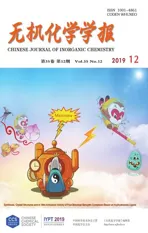两对由乳酸衍生物和刚性辅助配体构建的螺旋单一手性配位聚合物:合成、结构和性质
2019-12-11徐中轩石明凤
徐中轩 石明凤
(遵义师范学院化学化工学院,遵义 563002)
Helical chirality as a basic feature is widely existed in nature products and artificial materials[1-2].In living system,nucleic acid molecules with fascinating double helixes act as very important intermediates in storing and transferring genetic informations[3].In non-living system,carbohelicenes are constructed by an all carbon helical skeleton incorporating consecutive ortho-fused benzene rings,which have chirality and chiroptical properties[4].Therefore,the research on the chiral compounds with helical chains possesses both theoretical and realistic significance[5-7].
In homochiral coordination polymers(HCPs),helicity and chirality are often bound to each other,offering an approach to understand the relationship of chirality and helicity[8-10].Some methods,including spontaneous resolution,asymmetric induction and use of chiral ligands,have been developed to construct HCPs.Among them,self-assembly of chiral ligands and metal ions is the most direct and effective synthetic strategy.So the choice of chiral ligands is a key factor to gain multifunctional HCPs[11-14].
As cheap and readily available nature products,hydroxyl acids should be suitable enantiotopic linkers for the formation of HCPs.However,their flexible skeletons and preferred chelating coordination modes make it very difficult to obtain higher dimensional HCPs.To overcome these limitations,we used phydroxybenzoic acid to modify the-OH group of lactic acid,and synthesized a pair of lactate derivatives((R)-H2CBA and(S)-H2CBA)[15].Containing lactic acid and benzoic acid units,the(R)-H2CBA and(S)-H2CBA)have semi-rigid skeletons and multiple coordination modes,providing a convenient approach to synthesize HCPs(Scheme 1a)[16].Moreover,introduction of nitrogenous auxiliary ligands is also a feasible method in the synthesis process of HCPs.

Scheme 1 Synthetic routes of HCPs(a)and structures of auxiliary ligands 1,3-DIMB and 1,4-BMIP(b)
Based on these considerations,rigid 1,3-DIMB and 1,4-BMIP were chosen as auxiliary ligand to help(R)-H2CBA and(S)-H2CBA to build HCPs(Scheme 1b).Under hydrothermal conditions,two pair of Zn-based HCPs with helixes,namely,{[Zn((R)-CBA)(1,3-DIMB)]·H2O}n(1-D),{[Zn((S)-CBA)(1,3-DIMB)]·H2O}n(1-L),[Zn2((R)-CBA)2(1,4-BMIP)]n(2-D)and [Zn2((S)-CBA)2(1,4-BMIP)2]n(2-L)have been synthesized.Herein,their synthesis,crystal structures,thermal stabilities,CD spectra,and luminescent properties were reported.
1 Experimental
1.1 Materials and methods
All chemical reagent were purchased from Energy-Chemical and used without further purification except for(R)-H2CBA and(S)-H2CBA,which were synthesized according to the previously reported method[15].Elemental analysis was carried out on a Perkin-Elmer 240Celemental analyzer.FT-IRspectra were measured as KBr pellets on a Nicolet Magna 750 FT-IR spectrometer in a range of 400~4 000 cm-1.The powder Xray diffraction (PXRD)analysis was recorded on a Rigaku Dmax2500 diffractometer(U=40 kV and I=40 mA)with Cu Kαradiation (λ=0.154 056 nm)from 5.00°~50.00°(2θ).The luminescence spectra were performed on a Hitachi FL-4500 fluorescence spectrophotometer.Solid CD spectra were measured on a MOS-450 spectropolarimeter at room temperature.
1.2 Synthesis of{[Zn((R)-CBA)(1,3-DIMB)]·H 2O}n(1-D)
A mixture of Zn(BF4)2(36 mg,0.15 mmol),(R)-H2CBA (21 mg,0.1 mmol),1,3-DIMB (22 mg,0.1 mmol),Na2CO3(12.7 mg,0.12 mmol)and H2O(6 mL)was sealed in a 25 mL Teflon-lined stainless steel vessel and heated at 130℃for 3 days.After cooling to room temperature,the colourless block crystals 1-D were obtained with a yield of 40% (based on(R)-H2CBA).Anal.Calcd.for C25H26N4O6Zn(%):C,55.21;H,4.82;N,10.30.Found(%):C,56.04.1;H,4.32;N,9.88.IR(KBr,cm-1):3 428(m),1 603(s),1 598(m),1 414(m),1 387(m),1 355(m),1 306(m),1 238(m),1 169(w),854(w),786(w),730(w),681(w),656(w).
1.3 Synthesisof{[Zn((S)-CBA)(1,3-DIMB)]·H 2O}n(1-L)
The procedure was same as that of 1-D,except that(S)-H2CBA was replaced by(R)-H2CBA.Colorless block crystals of 1-L were obtained with a yield of 35%(based on(S)-H2CBA).Anal.Calcd.for C25H26N4O6Zn(%):C,55.21;H,4.82;N,10.30.Found(%):C,55.47;H,4.12;N,9.74.IR (KBr,cm-1):3 428(m),1 603(s),1 510(m),1 411(m),1 386(m),1 349(m),1 306(m),1 238(m),1 176(w),854(w),780(w),730(w),681(w),656(w).
1.4 Synthesis of[Zn2((R)-CBA)2(1,4-BMIP)2]n(2-D)
The procedure was same as that of 1-D,except that 1,4-BMIP was replaced by 1,3-DIMB.Colorless block crystals of 2-D were obtained with a yield of 35%(based on(R)-H2CBA).Anal.Calcd.for C33H29N5O10Zn2(%):C,50.40;H,3.72;N,8.91.Found(%):C,48.16;H,4.02;N,7.76.IR(KBr,cm-1):3 428(w),3 125(w),2 983(w),1 677(m),1 603(s),1 541(s),1 485(m),1 417(s),1 300(m),1 231(s),1 139(m),1 089(m),1 040(m),866(m),780(m),656(m),575(w),507(w).
1.5 Synthesis of[Zn2((S)-CBA)2(1,4-BMIP)2]n(2-L)
The procedure was same as that of 2-D,except that(S)-H2CBA was replaced by(R)-H2CBA.Colorless block crystals of 2-L were obtained with a yield of 30%(based on(S)-H2CBA).Anal.Calcd.for C33H29N5O10Zn2(%):C,50.40;H,3.72;N,8.91.Found(%):C 47.86,H 4.25,N 8.26.IR(KBr,cm-1):3 428(w),3 125(w),2 983(w),1 670(m),1 603(s),1 547(s),1 491(m),1 423(s),1 306(m),1 231(s),1 139(m),1 089(m),1 040(m),854(m),780(m),656(m),581(w),501(w).
1.6 Crystal structural determination
The single crystal diffraction data of 1-D,1-L,2-D and 2-L were collected on a Rigaku four-circle 003 CCD diffractometer at room temperature using graphite monochromated Mo Kα radiation(λ=0.071 073 nm).The data integration and reduction were carried out with Rigaku OD 2015 software.Empirical absorption corrections were applied by using spherical harmonics,implemented in SCALE3 ABSPACK scaling algorithm.In Olex2-1.2,the structures of complexes were solved by the direct methods using SHELXS-2017 and refined on F2by full-matrix least-squares using the SHELXL-2017 program package[17-18].All the hydrogen atoms were placed on their calculated positions and treated as riding atoms with default parameters.The crystal and refinement data are summarized in Table 1,while selective bond distances and angles are listed in Table 2.
CCDC:1917675,1-D;1917676,1-L;1917677,2-D;1917678,2-L.
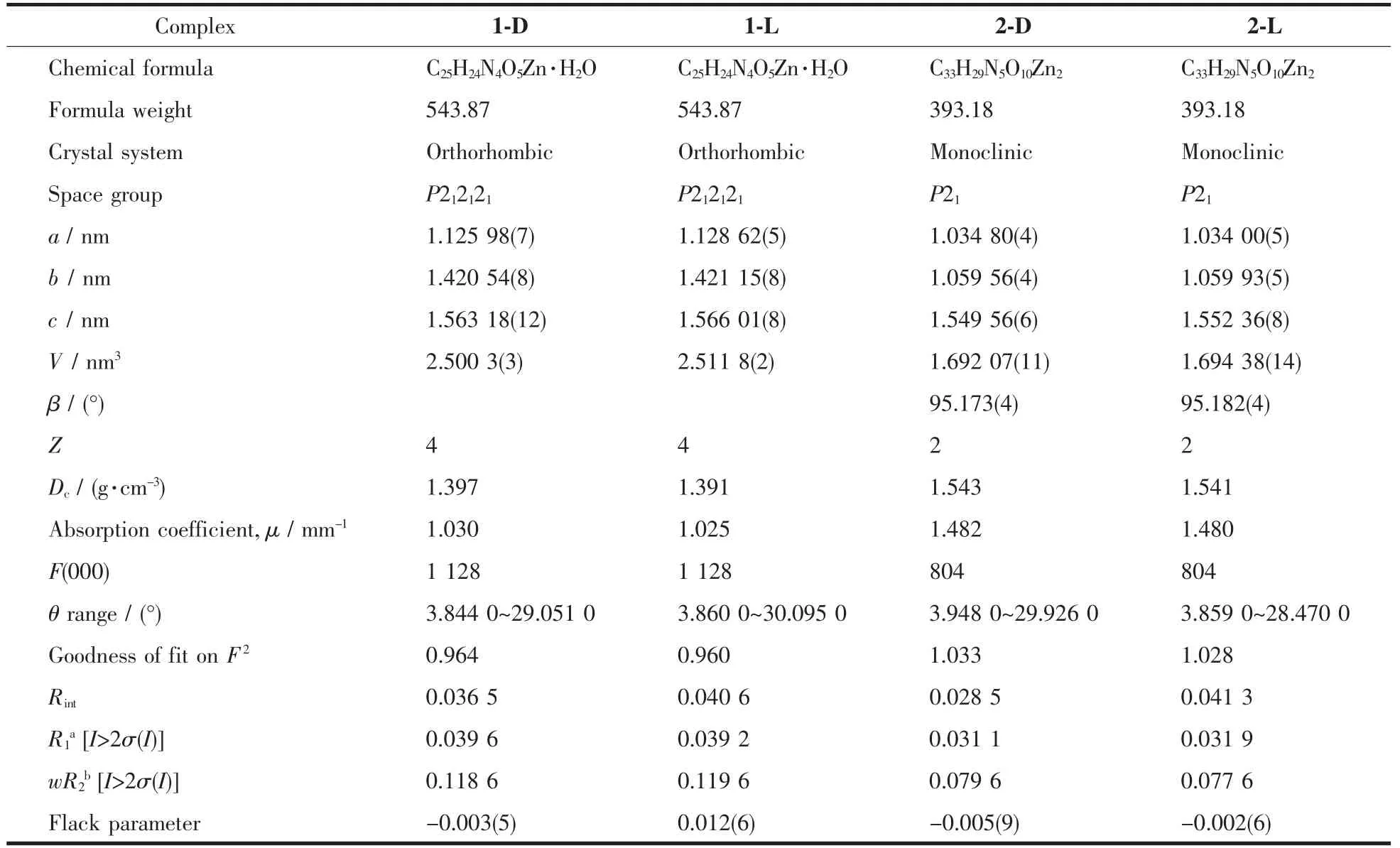
Table 1 Crystal data and structure refinement details for complexes

Table 2 Selected bond lengths(nm)and bond angels(°)in 1-D,1-L,2-L and 2-D
2 Results and discussion
2.1 Crystal structures of{[Zn((R)-CBA)(1,3-DIMB)]·H 2O}n(1-D)and{[Zn((S)-CBA)(1,3-DIMB)]·H 2O}n(1-L)
Single-crystal X-ray diffraction confirmed that complexes 1-D and 1-L crystallize in orthorhombic chiral space group P212121with Flack parameters of-0.003(5)and 0.012(6), respectively, indicating enantiomeric purity of the single crystals.As shown in Fig.1,the mirror-image structures of 1-D and 1-L revealed their enantiomeric nature.Sincethecomplexes 1-D and 1-L are enantiomers,we only discuss the detailed geometric features of 1-D.The asymmetric unit of 1-D contains one Zn(Ⅱ)ion,one deprotonated(R)-CBA2-ligand,one 1,3-DIMB ligand and two half guest waters.The Zn(Ⅱ)ion center displays a tetrahedral configuration and coordinates with two carboxyl oxygen atoms from two(R)-CBA2-ligands and two nitrogen atoms from two 1,3-DIMB ligands.
The outstanding structural feature of 1-D and 1-L is the presence of helical chains.In 1-D,the Zn(Ⅱ)ions are bridged by(R)-CBA2-ligands to form an infinite left-handed helical chain along the c axis(Fig.2a),and the opposite right-handed helical chain exists in 1-L (Fig.2b).Finally,the adjacent helical chains connect to each other by 1,3-DIMB ligands to construct the 2D framework of 1-D/1-L(Fig.2c~d).

Fig.1 Coordination environment in enantiomers 1-D and 1-L with 50%probability displacement ellipsoids
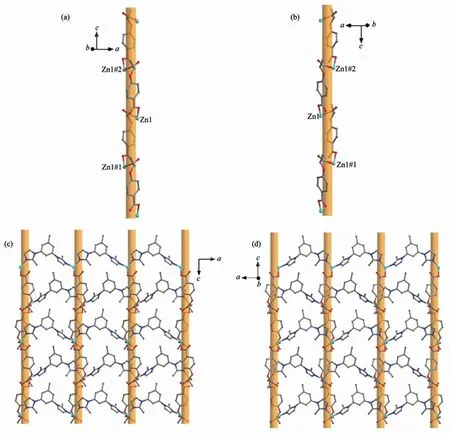
Fig.2 (a)Left-handed helical chain in 1-D;(b)Right-handed helical chain in 1-L;(c)2D layer of 1-D constructed by helical chains and 1,3-DIMB ligands;(d)2D layer of 1-L constructed by helical chains and 1,3-DIMB ligands
2.2 Crystal structures of[Zn2((R)-CBA)2(1,4-BMIP)2]n(2-D)and[Zn2((S)-CBA)2(1,4-BMIP)2]n(2-L)
Complexes 2-D and 2-L are also a pair of enantiomers(Fig.3)and crystallize in monoclinic chiral space group P21with Flack parameters of-0.005(9)and-0.002(6),respectively.In the same way,the complex 2-D is taken as representative to describe their structural features.The corresponding asymmetric unit is composed of two Zn2+centers,two deprotonated(R)-CBA2-ligands and one 1,4-BMIP ligand.The two(R)-CBA2-ligand connect three Zn2+centersasκ3-linker andκ4-linker,respectively.For the unique coordination modes of (R)-CBA2-ligands,a dinuclear cluster Zn2(CO2)4is formed.In the Zn2(CO2)4cluster,Zn1 shows a tetrahedral configuration coordinated by two carboxylate O atoms from three(R)-CBA2-ligands and two N atoms from two 1,4-BMIP ligands,while Zn2 shows distorted trigonal bipyramidal configuration connected by four carboxylate O atoms from three(R)-CBA2-ligands and one N atom from 1,4-BMIP.

Fig.3 Enantiomeric nature of complexes 2-D and 2-L with 50%probability displacement ellipsoids
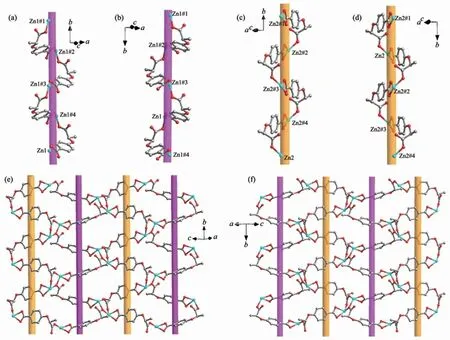
Fig.4 (a)Right-handed helical A-chain in 2-D;(b)Left-handed helical A-chain in 2-L;(c)Left-handed helical B-chain in
The structural features of 2-D and 2-L are also the helical chains similar to the 1-D and 1-L(Fig.4a~d).As shown in Fig.2a,the Zn1 centers in 2-D are 2-D;(d)Right-handed helical B-chain in 2-L;(e)Helical Zn-(R)-CBAlayer in 2-D;(f)Helical Zn-(S)-CBA layer in 2-L bridged by(R)-CBA2-ligands to form an infinite righthanded helical A-chain running along the b axis,and the opposite left-handed helical A-chain is constructed by(S)-CBA2-ligands and Zn1 ions in 2-L(Fig.4b).Besides helical A-chain, the(R)-CBA2-/(S)-CBA2-ligands can connect Zn2 centers to form another lefthanded/right-handed helical B-chain in 2-D/2-L(Fig.4c~d).According to the ratio of 1∶1,the helical Achains and B-chains build a 2D Zn-CBA layer(Fig.4e~f).
Finally,the adjacent Zn-(R)-CBA layers are connected together by the 1,4-BMIP ligands in 2-D,resulting in a 3D framework(Fig.5a).In the 3D framework,the Zn2(CO2)4units are regarded as 6-connected nodes,while the(R)-CBA3-ligands and 1,4-BMIP ligands are simple linkers.Thus,the whole framework of 2-D is topologically represented as a mab net with a point symbol of(44.610.8)(Fig.5b)[19].

Fig.5 Schematic illustrations of 2-D:3D frameworks(a)and mab net(b)
2.3 PXRD patterns and thermal analysis
To examine the purity of complexes 1-D,1-L,2-D and 2-L,their powder X-ray diffractions were measured at room temperature.As shown in Fig.S5~6,the corresponding experimental mains peaks are consistent with their simulated patterns,demonstrating the phase purity of the products.
Moreover,thermal behaviors of complexes 1-D,1-L,2-D and 2-L were also studied by TGA to check the thermal stabilities of frameworks (Fig.S7~8).The complexes 1-D and 1-L displayed the weight loss of 3.0%from room temperature to 105℃,which should be attributed to the release of a guest water molecule(Calcd.3.3%).Over 330℃,the frameworks started to decompose until 800°C without stopping(Fig.S7).However,TGA curves of complexes 2-D and 2-L showed that there is no weight loss until 380℃.After 380℃,the frameworks began to decompose(Fig.S8).
2.4 Circular dichroism
To further confirm the enantiomeric characteristic of complexes 1-D,1-L,2-D and 2-L,their CD experiments were carried out in KCl plates between 200 and 600 nm.As shown in Fig.6a,the CD spectrum of 1-D exhibited a positive Cotton effect at about 270 nm,while complex 1-L displayed a negative CD signal at the same position.Furthermore,complex 2-D showed a positive CD signal at 256 nm and a negative CD signal at 273 nm,and a mirror image was also observed for 2-L at the same position (Fig.6b).The above test results of CD spectrum indicate that complexes 1-D and 1-L,and 2-D and 2-L are enantiomers,respectively,and chirality of ligands (R)-H2CBA and(S)-H2CBA can be transferred to the corresponding coordination complex aggregates.
2.5 Photoluminescence properties
In consideration of the d10metal inorganicorganic hybrid coordination polymers with excellent luminescent properties,the solid-state photoluminescent spectra of complexes 1-D and 2-D were measured at room temperature.As depicted in Fig.7,the photoluminescent spectra have emission peaks with maxima at 420 nm(λex=355 nm)for 1-D,376 nm λex=310 nm)for 2-D,respectively.To better understand the above nature of emission band,the free ligand(R)-H2CBA was also investigated,which displayed an emission band at 320 nm (λex=280 nm).As compared to(R)-H2CBA,emission maxima of 1-D and 2-D have distinct red-shifts about 100 and 56 nm,respe-ctively,which should be ascribed to intraligand (n-π*orππ*)emission[20-21].
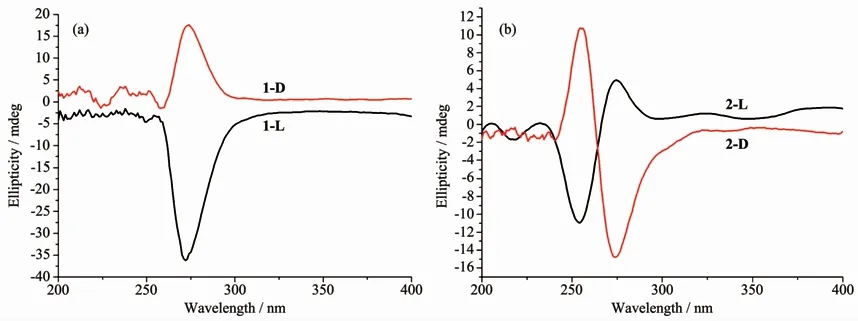
Fig.6 Solid-state CD spectra of complexes 1-D and 1-L(a),2-D and 2-L(b)
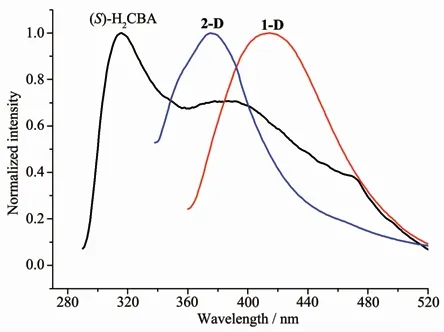
Fig.7 Photoluminescent spectra of 1-D,2-D and ligand(R)-H2CBA
3 Conclusions
In summary,two pairs of novel HCPs were prepared by hydrothermal method using lactate derivatives (R)-H2CBA and (S)-H2CBA as chiral ligands.In all the complexes,Zn(Ⅱ)centers and CBA2-ligands can construct different helical chains,which further prove that the helicity of HCPs can be dictated by the chirality of the ligands.With a variety of coordination modes,(R)-H2CBA and(S)-H2CBA are good candidates for the construction of interesting HCPs with helical chains.
Supportinginformation isavailableat http://www.wjhxxb.cn
